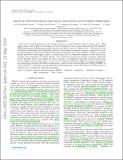Files in this item
Impact of type II spicules in the corona : simulations and synthetic observables
Item metadata
| dc.contributor.author | Martínez-Sykora, Juan | |
| dc.contributor.author | De Pontieu, Bart | |
| dc.contributor.author | De Moortel, Ineke | |
| dc.contributor.author | Hansteen, Viggo | |
| dc.contributor.author | Carlsson, Mats | |
| dc.date.accessioned | 2018-05-28T10:30:12Z | |
| dc.date.available | 2018-05-28T10:30:12Z | |
| dc.date.issued | 2018-06-19 | |
| dc.identifier | 253112287 | |
| dc.identifier | f3344015-6579-40d4-b5bb-8809df65ec66 | |
| dc.identifier | 85049155028 | |
| dc.identifier | 000435654900006 | |
| dc.identifier.citation | Martínez-Sykora , J , De Pontieu , B , De Moortel , I , Hansteen , V & Carlsson , M 2018 , ' Impact of type II spicules in the corona : simulations and synthetic observables ' , Astrophysical Journal , vol. 860 , no. 2 , 116 . https://doi.org/10.3847/1538-4357/aac2ca | en |
| dc.identifier.issn | 0004-637X | |
| dc.identifier.other | ORCID: /0000-0002-1452-9330/work/46569070 | |
| dc.identifier.uri | https://hdl.handle.net/10023/13569 | |
| dc.description | We gratefully acknowledge support by NASA grants, NNX16AG90G, NNH15ZDA001N, NNX17AD33G, and NNG09FA40C (IRIS), NSF grant AST1714955. This research has received funding from the UK Science and Technology Facilities Council (Consolidated Grant ST/K000950/1) and the European Union Horizon 2020 research and innovation programme (grant agreement No. 647214). This research was supported by the European Research Council under the European Union's Seventh Framework Programme (FP7/2007-2013) / ERC Grant agreement nr. 291058. We thankfully acknowledge the support of the Research Council of Norway through grant 230938/F50, through its Center of Excellence scheme, project number 262622, and through grants of computing time from the Programme for Supercomputing. | en |
| dc.description.abstract | The role of type II spicules in the corona has been a much debated topic in recent years. This paper aims to shed light on the impact of type II spicules in the corona using novel 2.5D radiative MHD simulations including ion-neutral interaction effects with the Bifrost code. We find that the formation of simulated type II spicules, driven by the release of magnetic tension, impacts the corona in various manners. Associated with the formation of spicules, the corona exhibits 1) magneto-acoustic shocks and flows which supply mass to coronal loops, and 2) transversal magnetic waves and electric currents that propagate at Alfvén speeds. The transversal waves and electric currents, generated by the spicule's driver and lasting for many minutes, are dissipated and heat the associated loop. These complex interactions in the corona can be connected with blue shifted secondary components in coronal spectral lines (Red-Blue asymmetries) observed with Hinode/EIS and SOHO/SUMER, as well as the EUV counterpart of type II spicules and propagating coronal disturbances (PCDs) observed with the 171 Å and 193 Å SDO/AIA channels. | |
| dc.format.extent | 5958185 | |
| dc.language.iso | eng | |
| dc.relation.ispartof | Astrophysical Journal | en |
| dc.subject | Magnetohydrodynamics (MHD) | en |
| dc.subject | Methods: numerical | en |
| dc.subject | Radiative transfer | en |
| dc.subject | Sun: atmosphere | en |
| dc.subject | Sun: corona | en |
| dc.subject | QB Astronomy | en |
| dc.subject | QC Physics | en |
| dc.subject | NDAS | en |
| dc.subject.lcc | QB | en |
| dc.subject.lcc | QC | en |
| dc.title | Impact of type II spicules in the corona : simulations and synthetic observables | en |
| dc.type | Journal article | en |
| dc.contributor.sponsor | European Research Council | en |
| dc.contributor.sponsor | Science & Technology Facilities Council | en |
| dc.contributor.sponsor | Science & Technology Facilities Council | en |
| dc.contributor.institution | University of St Andrews. Applied Mathematics | en |
| dc.contributor.institution | University of St Andrews. School of Mathematics and Statistics | en |
| dc.identifier.doi | 10.3847/1538-4357/aac2ca | |
| dc.description.status | Peer reviewed | en |
| dc.identifier.url | https://arxiv.org/abs/1805.06475 | en |
| dc.identifier.grantnumber | 647214 | en |
| dc.identifier.grantnumber | ST/N000609/1 | en |
| dc.identifier.grantnumber | ST/K000950/1 | en |
This item appears in the following Collection(s)
Items in the St Andrews Research Repository are protected by copyright, with all rights reserved, unless otherwise indicated.

